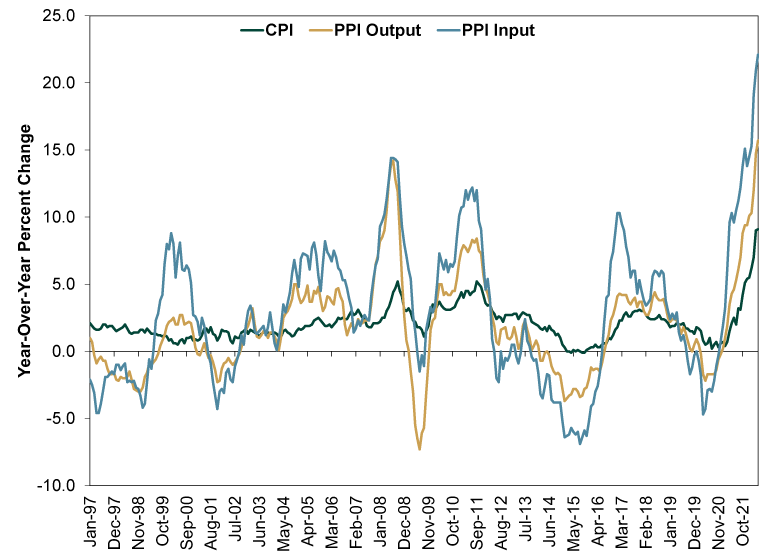Personal Wealth Management / Market Analysis
On Wednesday’s Dreary British and Canadian Inflation Data
As inflation gets worse, so does sentiment.
The Anglosphere got another inflation sucker-punch today, this time courtesy of May data from Canada and the UK. Unsurprisingly, inflation worsened in both nations, with consumer price index (CPI) inflation speeding to 7.7% y/y in the Great White North and 9.1% y/y in Britain.[i] And unsurprisingly, coverage was quite dour. That is understandable, considering inflation makes life difficult for many. It has also become a thorny political issue, so please understand that we are addressing this from an investing perspective only and don’t intend any political statements. To that end, while we don’t think either report yields any great insight from a data analysis standpoint, we find the reactions rather illuminating on sentiment, as they show how far expectations have deteriorated. We hesitate to call it capitulation, but it does indicate it shouldn’t take much for reality to surprise positively later this year, which could help bring stocks some relief.
In both places, coverage fixated on central bankers’ alleged failure to act against rising prices sooner and forecasts for inflation to get even worse before it gets better. There was a lot of finger-pointing from politicians, not to mention a chorus of calls for the Bank of Canada and Bank of England (BoE) to do more to tackle the problem. Yet pundits also bemoaned that the rate hikes they view as necessary to beat inflation also risked “possibly” inducing recession, echoing Fed head Jerome Powell’s comments to Congress today.[ii] Rock, meet hard place.
Forecasts for worse to come stem largely from the knowledge that oil and gas prices continued rising in June, with food and metals prices also jumping. The weaker Canadian dollar and British pound also fanned fears, as they raise import costs. That got the blame for Canadian services prices rising 5.2% y/y, which seems rather suspect considering US services inflation is even faster at 5.7% y/y in May and the dollar has soared this year.[iii] In our view, a better explanation is that services prices are under a trio of pressures from reopening-fueled demand, supply costs and labor shortages, creating a classic supply/demand mismatch. We think it is a global pandemic-driven dislocation that, while frustrating, is likely to ease as economies gradually return to pre-lockdown trends. But if a hyper-focus on weak currencies creates much more dismal expectations, then so much the better for stocks. Surprise power will be that much easier to attain.
In our view, there is very little central banks can do to fix this. Monetary policy hits the economy at a lag, with many studies showing the effect materializes 6 – 18 months out. It also tends to impact private investment more than consumer demand, which doesn’t solve the immediate problem. On the goods front, central banks have even less power, as inflation stems primarily from food and commodity prices. The Bank of Canada and BoE can influence money supply growth through their benchmark interest rates and their efforts to encourage or discourage the accumulation of bank reserves. But they can’t drill oil wells. They can’t build liquefied natural gas export and import terminals to increase supply into Europe. They can’t build next-generation nuclear power plants or arrange government permits for private entities to do so. They can’t reopen mothballed nuclear facilities and coal or gas-fired plants in Europe. They can’t open mines. They can’t end the war in Ukraine, plant grain or raise chickens and cattle. They can’t make China’s government abandon its zero-COVID strategy. You get the point. So in our view, calls for aggressive rate hikes to solve this mess are just a tad wide of the mark.
Some pundits seemingly acknowledged this in their calls for inflation to get much worse from here, but their logic has some other holes—holes that should offer some encouragement. The UK released producer price inflation (PPI) alongside CPI, and it was ugly. Manufacturers’ input prices jumped 22.1% y/y, and their output prices—aka the prices factories charge the wholesalers they sell to—rose 15.7%.[iv] Hence, UK pundits warned businesses have plenty more cost increases to pass on to consumers, seemingly on the belief that consumer prices don’t yet fully reflect wholesale prices, which don’t yet fully reflect input costs.
However, a look at these series’ history dispels the myth that input prices predict wholesale prices predict consumer prices. As Exhibit 1 shows, since overlapping data begin in January 1997, all three have moved pretty similarly in terms of direction, with producer prices not leading consumer prices on a consistent basis. Many of their inflection points coincide. The differences are largely in magnitude, not direction.
Exhibit 1: Directionally, Consumer and Producer Prices Often Move Together

Source: UK Office for National Statistics, as of 6/22/2022. UK CPI, UK Output PPI and UK Input PPI, year-over-year percent change, January 1997 – May 2022.
When you consider how supply chains work, this makes sense. Commodity costs tend to swing wildly, leading to those outsized input PPI swings. But those don’t translate exactly to wholesale prices, which also reflect labor and fixed overhead costs plus markup—all of which can temper the amount factories have to raise their prices of finished goods. Similarly, wholesale prices are but one ingredient in consumer prices, which also reflect costs of labor, marketing, distribution and retailers’ fixed overhead as well as markup. So even if retailers pass on the full wholesale price increase, those other factors may swing less, keeping the consumer price index relatively milder.
So, in our view, nothing about today’s PPI report should automatically suggest UK inflation will soar far higher from here. Now, we do think there is still more pain in store, stemming partly from ongoing fuel price increases and October’s pending increase to Britain’s household energy price cap, which fresh estimates show could rise about 50% from April. That is … ouch. Given oil is also a key feedstock for all manner of consumer goods, we will likely continue seeing it impact non-energy inflation as well. The BoE currently sees UK inflation hitting 11% y/y later this year, and it could prove correct. But those forecasts aren’t new or surprising to markets, which are also discounting the hysteria over PPI and handwringing over central banks’ fecklessness. All of these fears and projections are getting baked into stock prices.
The lower expectations go, the easier it is for reality to deliver a positive surprise. Less bad than feared often suffices in this environment. That obviously isn’t what people will want to hear about inflation at a fundamental day-to-day living level, as rising living costs can have a devastating personal impact. But markets are cold-hearted to such things, and we suspect any indication that inflation won’t peak as high or last as long as everyone now fears would generate some welcome relief for stocks.
Always remember: Markets don’t wait for perfection and all-clear signals. They move first, and recoveries often happen when things look darkest. Again, we aren’t saying that time is now—inflection points are only ever visible in hindsight. More negativity could be in store. But if stocks are at all efficient, then a recovery will probably begin before the world fathoms inflation relief. With pundits basing dreary forecasts on faulty inputs and logic, we think that relief could arrive much sooner than expected.
If you would like to contact the editors responsible for this article, please message MarketMinder directly.
*The content contained in this article represents only the opinions and viewpoints of the Fisher Investments editorial staff.
Get a weekly roundup of our market insights
Sign up for our weekly e-mail newsletter.

See Our Investment Guides
The world of investing can seem like a giant maze. Fisher Investments has developed several informational and educational guides tackling a variety of investing topics.





